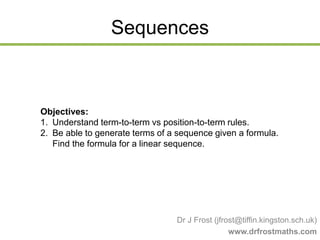The document discusses linear sequences and how to find the formula for the nth term of a linear sequence. It provides examples of sequences where the difference between terms is constant, and explains that this allows you to write the formula in the form of an + b, where a is the constant difference and b is a correction term. It also discusses using the formula to determine if a given number is part of the sequence.





![[JMC 2009 Q11] In a sequence of numbers, each term after
the first three terms is the sum of the previous three terms.
The first three terms are -3, 0, 2. Which is the first term to
exceed 100?
A 11th term B 12th term C 13th term
D 14th term E 15th term
JMC Puzzle
C
B
A D E
Terms are: -3, 0, 2, -1, 1, 2, 2, 5, 9, 16, 30, 55, 101](https://image.slidesharecdn.com/sequences-220803092622-6402c741/85/Sequences-pptx-6-320.jpg)


![Exercise 1
In a sequence, each term after the first is the
sum of the squares of the digits of the previous
term. Thus if the first term were 12, the second
term would be 12 + 22 = 5, the third term 52 =
25, the fourth term 22 + 52 = 29, and so on. Find
the first five terms of the sequence whose first
term is 25. 25, 29, 85, 89, 145
The first three terms of a sequence are
1
4
,
1
3
,
1
2
.
The fourth term is
1
2
−
1
3
+
1
4
; henceforth, each
new term is calculated by taking the previous
term, subtracting the term before that, and then
adding the term before that.
Write down the first six terms of the sequence,
giving your answers as simplified fractions.
𝟏
𝟒
,
𝟏
𝟑
,
𝟏
𝟐
,
𝟓
𝟏𝟐
,
𝟏
𝟒
,
𝟏
𝟑
[JMO 2010 B1] In a sequence of six numbers,
every term after the second term is the sum of
the previous two terms. Also, the last term is
four times the first term, and the sum of all six
terms is 13. What is the first term?
Solution: 𝟏
𝟏
𝟒
Find the 100th term of the sequences with
the following formulae for the 𝑛th term:
a) 8𝑛 − 3 797
b) 3 − 𝑛 -97
c) 3𝑛2
− 𝑛 + 1 29901
A sequence starts with 1. Thereafter, each
new term is formed by adding all the
previous terms, and then adding 1. What
are the first 6 terms? 1, 2, 4, 8, 16,
32
Find the first 4 terms of the following
sequences:
a) 𝑛 + 3 4, 5, 6, 7
b) 3𝑛
3, 9, 27, 81
c) 𝑛3
− 𝑛2
0, 4, 18, 48
d) 𝑛2
− 4𝑛 + 1 -2, -3, -2, 1
e) 𝑛! (use your calculator) 1, 2, 6, 24
The first two terms of a sequence are 1 and
2. Each of the following terms in the
sequence is the sum of all the terms which
come before it in the sequence. Which of
these is not a term in the sequence?
A 6 B 24 C 48 D 72 E 96
(Hint: perhaps represent
the first two terms
algebraically?)
?
?
?
?
?
?
?
?
?
?
?
?
1
2
3
4
5
6
N](https://image.slidesharecdn.com/sequences-220803092622-6402c741/85/Sequences-pptx-9-320.jpg)







